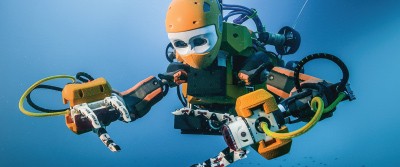Robo-Mermaid Discovers Ancient Shipwreck

By Celeste Beley
Imagine finding treasure from a shipwreck, untouched for over 350 years, without even getting into the water. Seems impossible, right? But a new humanoid robot could allow for discoveries like this and more in the deepest depths of our planet’s waters.
OceanOne, the humanoid robot developed by Oussama Khatib, enables humans to discover and explore parts of the ocean that have previously been unreachable, all while remaining dry aboard a nearby boat. A professor of computer science at Stanford University, Khatib initially developed OceanOne to study coral reefs in the Red Sea, a depth far greater than human divers can comfortably go. The prototype combines human-like vision, robotics, artificial intelligence and haptic feedback systems that work together to create a one-of-a-kind robot.
On its maiden voyage, OceanOne swam through the wreckage of La Lune, the flagship of King Louis XIV of France, which sank in the Mediterranean in 1664. This ship has remained untouched by humans for centuries, but OceanOne was able to explore the wreckage and recover from it a vase, fully intact, which it brought to the surface.
Anatomy of a Robo-Mermaid
The head of the approximately five-foot-long robot features stereoscopic vision — allowing the pilot to see exactly what OceanOne sees — as well as two fully articulated arms. At the ends of those arms are hands equipped with force sensors that relay haptic feedback to the pilot’s controls, which allow the human to gauge whether the robot is holding something light or something heavy. Besides shipwrecks, the robot can also handle delicate coral reef research and sensor placement.
While a pilot can control OceanOne, the robot is able to perform without human interaction. Sensors detect current and turbulence data that automatically adjust thrusters to keep the robot in place and activate quickfiring motors to keep the arms steady. Multiple sensors and cameras also give OceanOne a full perception of the surrounding environment while the robot runs data through algorithms to help it avoid collisions.
OceanOne was ultimately developed to perform tasks deemed impossible or too dangerous for humans, including deep-water mining, oil-rig maintenance and even dealing with underwater disaster situations. But its combination of technology with human expertise makes it truly unique. “We connect the human to the robot in very intuitive and meaningful ways. The human can provide intuition and expertise and cognitive abilities to the robot,” Khatib said. “The two bring together an amazing synergy. The human and robot can do things in areas too dangerous for a human, while the human is still there.”
CLASSROOM DISCUSSION
Think of all the applications for a robot like OceanOne. What application do you think would have the biggest impact, and why?
VOCABULARY
- Haptic Feedback
- Turbulence
- Steroscopic